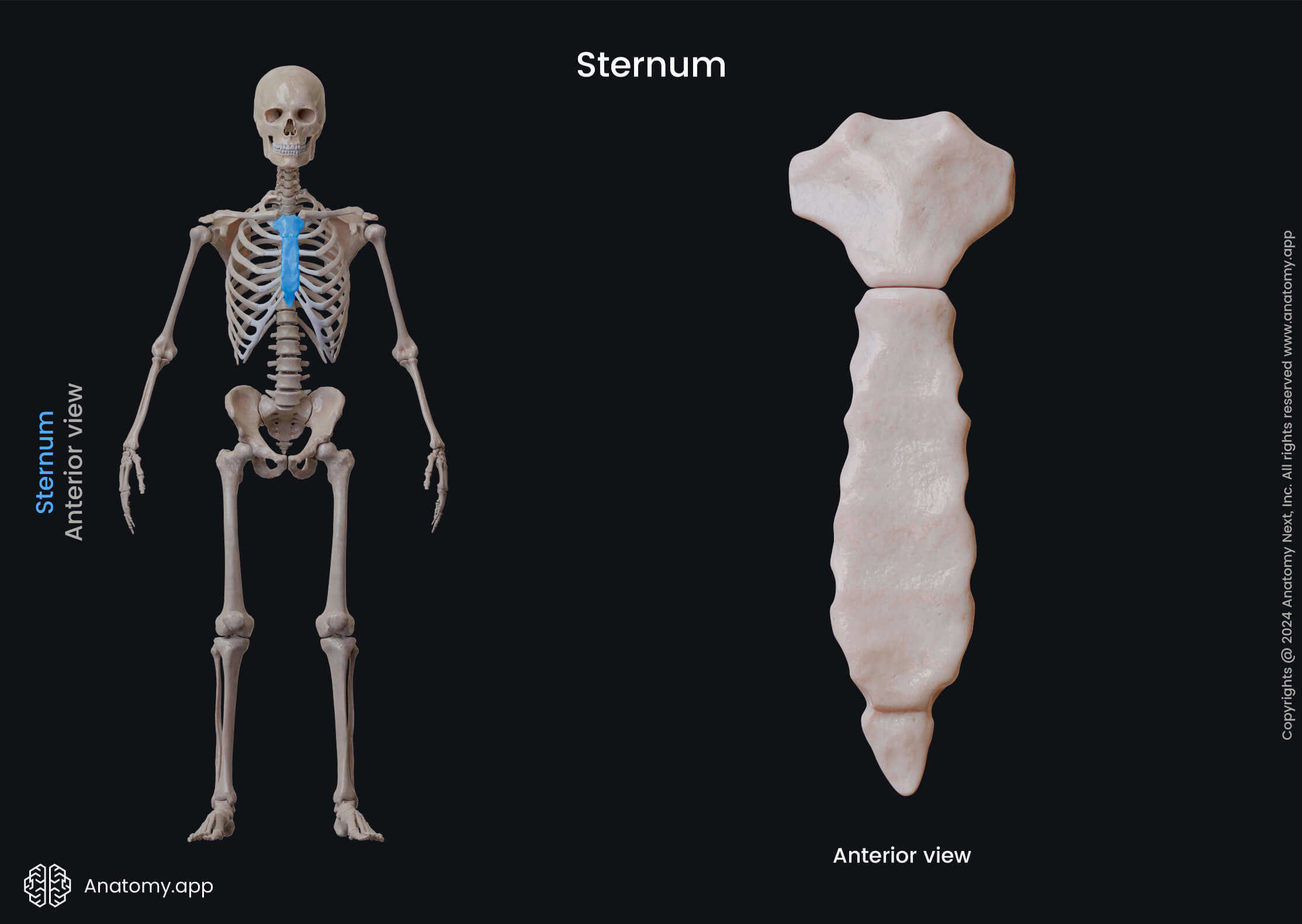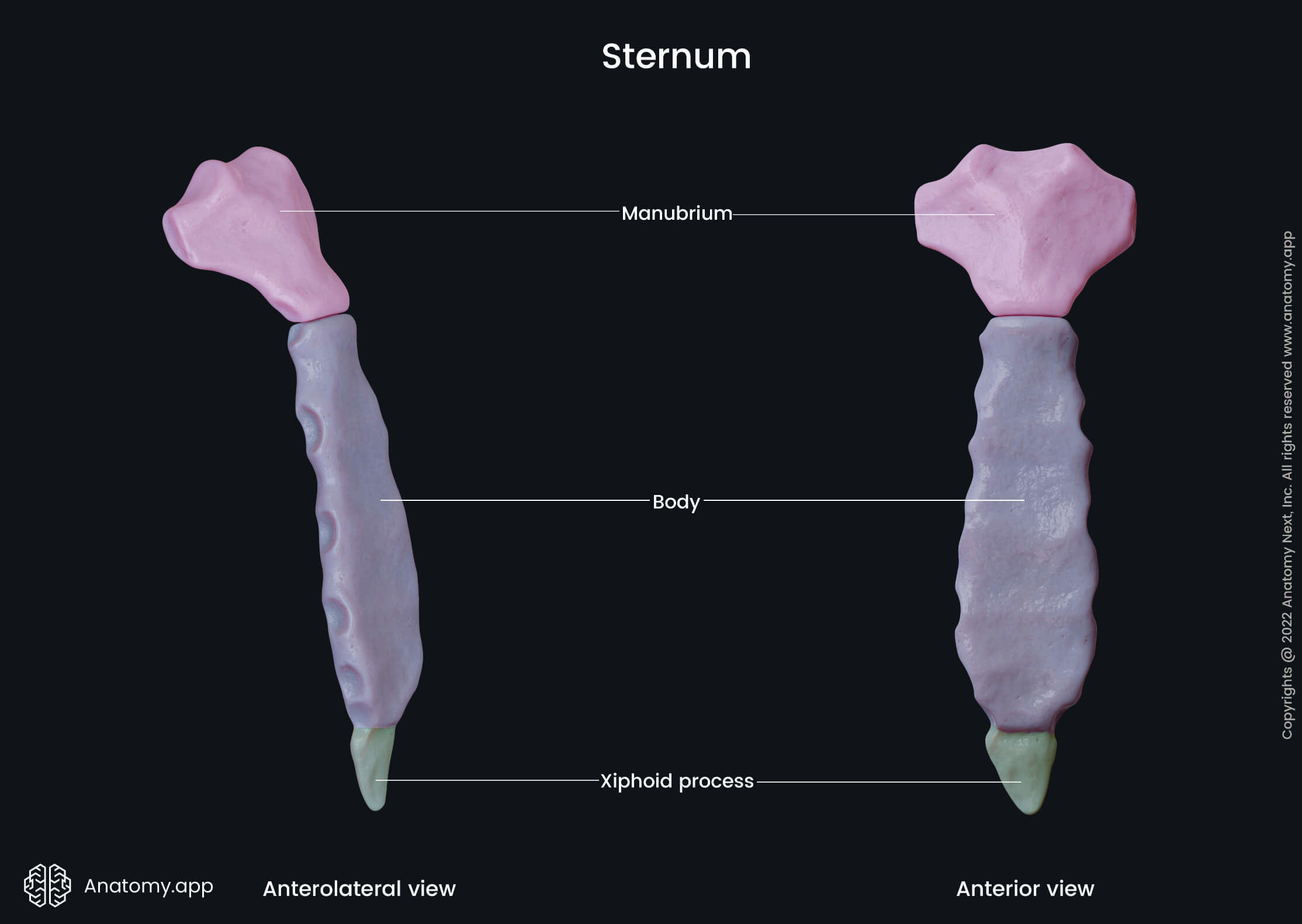- Anatomical terminology
- Skeletal system
- Skeleton of trunk
- Skull
- Skeleton of upper limb
- Skeleton of lower limb
- Joints
- Muscles
- Heart
- Blood vessels
- Lymphatic system
- Nervous system
- Respiratory system
- Digestive system
- Urinary system
- Female reproductive system
- Male reproductive system
- Endocrine glands
- Eye
- Ear
Sternum
The sternum (or breastbone, Latin: sternum) is a long, flat bone that is located in the anterior midline of the thorax. The sternum is connected to the first seven ribs via their costal cartilages. This bone forms the anterior part of the thoracic cage, thus participating in the protection of internal thoracic organs from injury. The word “sternum” originates from Ancient Greek language, meaning “chest.”

The sternum participates in forming several joints. The cartilages of the upper seven ribs articulate with the sternum at the sternocostal joints. The right and left clavicular notches articulate with the right and left clavicles, respectively. The top of the sternum supports the clavicles and its edges are connected with the costal cartilages of the first two pairs of ribs.
The upper part of the sternum is also connected with the sternocleidomastoid muscle. But the inner surface of the sternum serves for the attachment of the sternopericardial ligaments. The posterior surface of the lower sternum is the superior attachment site for the transversus thoracis muscle.
Normally, the sternum is positioned obliquely, downward and forward. Its frontal side is slightly convex, while its posterior side is concave. The sternum is shaped like “T” and becomes narrowed at the point where manubrium joins the body, after which it widens again and narrows at its lower and.
The length of the sternum is about 17 centimeters in adults, usually, longer in the male than in the female body. The sternum has three distinct parts or elements:
- Manubrium - the most superior part that articulates with clavicles and the first pair of ribs;
- Body - the middle part that articulates with 3rd to 7th ribs;
- Xiphoid process - a small extension of the lower sternum.

Manubrium of sternum
The manubrium is the broad upper segment of the sternum that forms part of the bony framework of the neck and the thorax. The superior part of the manubrium expands laterally and has a distinct and palpable notch in the midline, called the jugular notch or suprasternal notch. On each side of this notch is a large oval fossa for articulation with the clavicle.
Immediately below this fossa, on each lateral side of the manubrium is a facet for attachment of the first costal cartilage. On the lower lateral side of the manubrium is a demifacet, which together with a similar facet on the body, forms a cavity for articulation with the second costal cartilage.
Body of sternum
The body of the sternum is the flat, narrow and longitudinally oriented middle part of the sternum. It is attached to the manubrium of the sternum above, and with the xiphoid process below. It is common that the anterior surface of the body has transverse ridges that represent lines of fusion between the segments called sternebrae, from which this part of the sternum formed during embryogenesis.

The lateral sides of the body are marked by facets for articulation with costal cartilages. Superiorly, each lateral margin has a demifacet for articulation with the lower half of the second costal cartilage. Below this demifacet are four facets for articulation with costal cartilages of ribs 3 to 6. At the lower part of the body of the sternum is a demifacet for articulation with the upper part of the costal cartilage of rib 7.

Xiphoid process
The xiphoid process is the smallest part of the sternum, located inferiorly. It extends downwards from the body of the sternum. The word xiphoid is derived from Greek and means “swordlike”. The shape of the xiphoid process is variable: it can be thin, wide, pointed, bifid, curved, or perforated. On each side of its upper lateral margin is a demifacet for articulation with the lower part of the seventh costal cartilage.